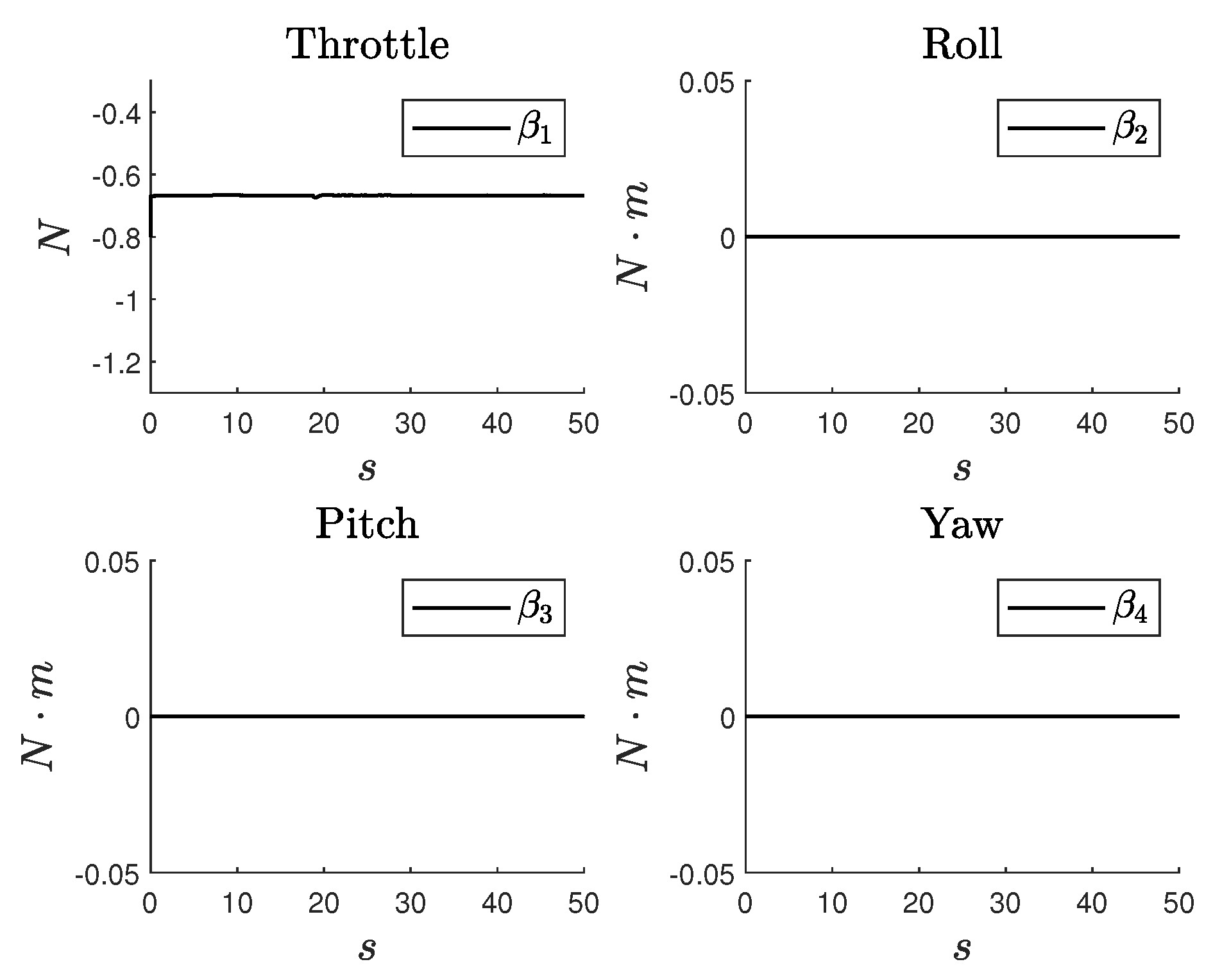Identification of High-Order Nonlinear Coupled Systems Using a Data-Driven Approach
Abstract
1. Introduction
1.1. Motivation
1.2. Contribution
1.3. Manuscript Organization
2. Mathematical Tools
2.1. LS
2.2. SINDY
2.3. Mathematical Model of a Quadcopter
2.4. Simulink Support Package for Parrot Minidrones
3. Identification of a High-Order Nonlinear Systems with Coupled Dynamics Using the Classical SINDY Algorithm
4. Identification of a High-Order Nonlinear Systems with Coupled Dynamics through the Modified SINDY Algorithm
4.1. GenesisXi Algorithm
4.2. Modified SINDY Algorithm
5. Discussion
- 1.
- In the specific case study, the outcomes achieved through the classical SINDY algorithm do not align with physics-based identification. Moreover, they do not qualify as sparse identification, as all candidate functions are present in the matrix .
- 2.
- Based on the knowledge of the structure of the complex system to be identified, a more precise algorithm has been introduced without a significant increase in computational cost.
- 3.
- Although the identified model appears to have significant differences from the related model found in the literature, it enables the design of a controller capable of stabilizing the original high-order nonlinear system with coupled dynamics. This, in turn, demonstrates its notable approximation degree.
- 4.
- The primary drawback of the proposed approach is that the identification problem transforms into a coefficient identification task. Nevertheless, in many real-world applications, this outcome may still be appealing because, in numerous cases, it is impossible to precisely determine the coefficients of a specific system, even when the structure of its mathematical model is available.
6. Conclusions
Author Contributions
Funding
Informed Consent Statement
Data Availability Statement
Acknowledgments
Conflicts of Interest
Definitions
| A | Coefficient matrix for the least squares problem. |
| b | Vector of observed or measured values for the least squares problem. |
| x | Vector of unknowns for the least squares problem. |
| Estimate or optimal solution for the least squares problem. | |
| X | Matrix whose columns are the states of the system, and the rows are the values of these states at different sampling instants. |
| Matrix whose columns are the first-time derivatives of the states of the system, and the rows are the values of such derivatives at different sampling instants. | |
| U | Matrix whose columns are the input signals of the system, and the rows are the values of such inputs at different sampling instants. |
| Matrix whose columns constitute the library of candidate functions, dependent on the states and/or inputs of the nonlinear system. The rows represent the values of these functions at various sampling instants. | |
| Sparse coefficient matrix that characterizes the importance or contribution of each term in the library of candidate functions (represented by ) to the dynamics of the system. | |
| Template for , representing the structure of the nonlinear systems. |
Appendix A. Pseudocodes and MATLAB Functions
Appendix A.1. Classical SINDY Algorithm
- Given a series of snapshots , and the corresponding time derivatives of a dynamical system , arrange them into matrices , and where m is the number of samples, n is the dimension of the state vector, and p is the dimension of the input vector.
Algorithm A1 SINDY algorithm Require: Data matrix X, U, and derivative matrix Ensure: Sparse model 1: Construct a library of candidate functions 2: Solve the sparse regression problem using a sparsity-promoting technique (e.g., LASSO) 3: Identify the active terms and coefficients in that form the model - Construct a library of nonlinear candidate functions of size , where q is the number of candidate functions. These functions can be constant, polynomial, trigonometric, or more exotic functions of the x and u.
- Solve the sparse regression problem , where is a matrix of coefficients of size , by minimizing the objective functionwhere is the Frobenius norm, is the norm, and is a regularization parameter that controls the sparsity of .
- Identify the sparse set of active terms in by selecting the rows of that have nonzero entries. These terms form the governing equations of the dynamical system:where is the i-th row of and is the i-th candidate function.
Appendix A.2. Classical SINDY (MATLAB Code)
| Listing A1. MATLAB function for the classical SINDY. |
 |
Appendix A.3. GenesisXi Algorithm
- Given the vector , whose elements contain the number of the differential equation where the corresponding candidate function should be located, and n, which is the dimension of the nonlinear system to be estimated, the matrix is set to zero. For this case, .
- The vector is traversed from its first element to the last using the index k, simultaneously placing a “1” at the position in the matrix .
| Algorithm A2 GenesisXi algorithm |
|
Appendix A.4. GenesisXi (Matlab Code)
| Listing A2. MATLAB function for the GenesisXi algorithm. |
 |
Appendix A.5. Modified SINDY (Matlab Code)
| Listing A3. MATLAB function with modifications to classical SINDY. |
 |
References
- Editorial. The rise of data-driven modelling. Nat. Rev. Phys. 2021, 3, 845–855. [Google Scholar] [CrossRef]
- Moghadas, S.M.; Jaberi-Douraki, M. Mathematical Modelling: A Graduate Textbook; John Wiley & Sons, Inc.: Hoboken, NJ, USA, 2019. [Google Scholar]
- Montáns, F.J.; Chinesta, F.; Gómez-Bombarelli, R.; Kutz, J.N. Data-driven modeling and learning in science and engineering. Comptes Rendus Mécanique 2019, 347, 845–855. [Google Scholar] [CrossRef]
- Devo, A.; Mao, J.; Costante, G.; Loianno, G. Autonomous Single-Image Drone Exploration with Deep Reinforcement Learning and Mixed Reality. IEEE Robot. Autom. Lett. 2022, 7, 5031–5038. [Google Scholar] [CrossRef]
- Schmidt, M.; Lipson, H. Distilling Free-Form Natural Laws from Experimental Data. Science 2009, 324, 81–85. [Google Scholar] [CrossRef] [PubMed]
- Peña-García, R.; Velázquez-Sánchez, R.; Gómez-Daza-Argumedo, C.; Escobedo-Alva, J.; Tapia-Herrera, R.; Meda-Campaña, J. Physics-Based Aircraft Dynamics Identification Using Genetic Algorithms. Aerospace 2024, 11, 142. [Google Scholar] [CrossRef]
- Haring, M.; Grøtli, E.I.; Riemer-Sørensen, S.; Seel, K.; Hanssen, K.G. A Levenberg–Marquardt Algorithm for Sparse Identification of Dynamical Systems. IEEE Trans. Neural Netw. Learn. Syst. 2022, 34, 9323–9336. [Google Scholar] [CrossRef]
- Tibshirani, R. Regression Shrinkage and Selection Via the Lasso. J. R. Stat. Soc. Ser. B (Methodological) 1996, 58, 267–288. [Google Scholar] [CrossRef]
- Brunton, S.L.; Proctor, J.L.; Kutz, J.N. Discovering governing equations from data by sparse identification of nonlinear dynamical systems. Proc. Natl. Acad. Sci. USA 2016, 113, 3932–3937. [Google Scholar] [CrossRef] [PubMed]
- Hansen, P.C.; Pereyra, V.; Scherer, G. Least Squares Data Fitting with Applications; Johns Hopkins University Press: Baltimore, MD, USA, 2013. [Google Scholar]
- Bertrand, Q.; Klopfenstein, Q.; Blondel, M.; Vaiter, S.; Gramfort, A.; Salmon, J. Implicit differentiation of Lasso-type models for hyperparameter optimization. In Proceedings of the 37th International Conference on Machine Learning, Virtual Event, 13–18 July 2020; Daume, H., Singh, A., Eds.; Proceedings of Machine Learning Research. JMLR: Cambridge, MA, USA, 2020; Volume 119, pp. 810–821. [Google Scholar]
- Brunton, S.L.; Kutz, J.N. Data-Driven Science and Engineering: Machine Learning, Dynamical Systems, and Control; Cambridge University Press: Cambridge, MA, USA, 2019. [Google Scholar] [CrossRef]
- Burrage, P.M.; Weerasinghe, H.N.; Burrage, K. Using a library of chemical reactions to fit systems of ordinary differential equations to agent-based models: A machine learning approach. Numer. Algorithms 2024. [Google Scholar] [CrossRef]
- Cao, R.; Lu, Y.; He, Z. System identification method based on interpretable machine learning for unknown aircraft dynamics. Aerosp. Sci. Technol. 2022, 126, 107593. [Google Scholar] [CrossRef]
- Callaham, J.L.; Brunton, S.L.; Loiseau, J.C. On the role of nonlinear correlations in reduced-order modelling. J. Fluid Mech. 2022, 938, A1. [Google Scholar] [CrossRef]
- Sargsyan, S.; Brunton, S.L.; Kutz, J.N. Nonlinear model reduction for dynamical systems using sparse sensor locations from learned libraries. Phys. Rev. E 2015, 92, 033304. [Google Scholar] [CrossRef]
- Loiseau, J.C.; Brunton, S.L. Constrained sparse Galerkin regression. J. Fluid Mech. 2018, 838, 42–67. [Google Scholar] [CrossRef]
- Loiseau, J.-C.; Brunton, S.L.; Noack, B.R. 9 From the POD-Galerkin method to sparse manifold models. In Volume 3 Applications; De Gruyter: Berlin, Germany; Boston, MA, USA, 2021; pp. 279–320. [Google Scholar] [CrossRef]
- Zavialov, V.; Lobok, O.; Mysiura, T.; Popova, N.; Chornyi, V.; Pohorilyi, T. Identification of unknown parameters of the dynamic model of mass transfer. Math. Model. Anal. 2023, 28, 459–468. [Google Scholar] [CrossRef]
- Hritonenko, N.; Satsky, C.; Yatsenko, Y. Integral model of COVID-19 spread and mitigation in UK: Identification of transmission rate. Math. Model. Anal. 2022, 27, 573–589. [Google Scholar] [CrossRef]
- Dodge, Y. The Concise Encyclopedia of Statistics-Least-Squares Method; Springer: New York, NY, USA, 2008. [Google Scholar] [CrossRef]
- Margalit, D.; Rabinoff, J. Interactive Linear Algebra; Georgia Institute of Technology: Atlanta, GA, USA, 2019. [Google Scholar]
- Lay, D.C.; McDonald, J.J.; Lay, S.R. Linear Algebra and Its Applications; Pearson: New York, NY, USA, 2016. [Google Scholar]
- Phillips, W.F. Mechanics of Flight; John Wiley and Sons, Inc.: Hoboken, NJ, USA, 1980. [Google Scholar]
- Meda-Campaña, J.A.; Torres-Cruz, R.E.; Rojas-Ruiz, A.J.; Tapia-Herrera, R.; Hernández-Cortés, T.; Páramo-Carranza, L.A. The Output Regulation and the Kalman Filter as the Signal Generator. IEEE Access 2023, 11, 90825–90838. [Google Scholar] [CrossRef]
- Jennie, Y.; Fathurrahman, A.; Arifianto, O.; Sasongko, R. Mathematical modelling and simulation of a quadrotor unmanned aerial vehicle with automatic altitude and speed control. AIP Conf. Proc. 2020, 2226, 020011. [Google Scholar]
- Collazos Morales, C.A.; Ospina, J.P.; Sánchez, J.F.; Caro-Ruiz, C.; Grisales, V.H.; Ariza-Colpas, P.; De-la Hoz-Franco, E.; González, R.E. Mathematical Modelling and Identification of a Quadrotor. In Proceedings of the International Conference on Computational Science and Its Applications, Cagliari, Italy, 1–4 July 2020; Springer: Berlin/Heidelberg, Germany, 2020; pp. 261–275. [Google Scholar]
- Mohamed, A.; Elsayed, M.; Elshafei, M. A Comparative Study Between a Classical and Optimal Control of a Quadrotor UAV. arXiv 2020, arXiv:2009.13175. [Google Scholar]
- MathWorks. Parrot Minidrones Support from Simulink. 2023. Available online: https://www.mathworks.com/hardware-support/parrot-minidrones.html (accessed on 8 March 2024).
- MathWorks. Simulink Support Package for Parrot Minidrones Documentation. 2023. Available online: https://www.mathworks.com/help/supportpkg/parrot/ (accessed on 8 March 2024).
- Kailath, T. Linear Systems; Prentice–Hall, Inc.: Hoboken, NJ, USA, 1980. [Google Scholar]






Disclaimer/Publisher’s Note: The statements, opinions and data contained in all publications are solely those of the individual author(s) and contributor(s) and not of MDPI and/or the editor(s). MDPI and/or the editor(s) disclaim responsibility for any injury to people or property resulting from any ideas, methods, instructions or products referred to in the content. |
© 2024 by the authors. Licensee MDPI, Basel, Switzerland. This article is an open access article distributed under the terms and conditions of the Creative Commons Attribution (CC BY) license (https://creativecommons.org/licenses/by/4.0/).
Share and Cite
Velázquez-Sánchez, R.D.; Escobedo-Alva, J.O.; Peña-García, R.; Tapia-Herrera, R.; Meda-Campaña, J.A. Identification of High-Order Nonlinear Coupled Systems Using a Data-Driven Approach. Appl. Sci. 2024, 14, 3864. https://doi.org/10.3390/app14093864
Velázquez-Sánchez RD, Escobedo-Alva JO, Peña-García R, Tapia-Herrera R, Meda-Campaña JA. Identification of High-Order Nonlinear Coupled Systems Using a Data-Driven Approach. Applied Sciences. 2024; 14(9):3864. https://doi.org/10.3390/app14093864
Chicago/Turabian StyleVelázquez-Sánchez, Rodolfo Daniel, Jonathan Omega Escobedo-Alva, Raymundo Peña-García, Ricardo Tapia-Herrera, and Jesús Alberto Meda-Campaña. 2024. "Identification of High-Order Nonlinear Coupled Systems Using a Data-Driven Approach" Applied Sciences 14, no. 9: 3864. https://doi.org/10.3390/app14093864
APA StyleVelázquez-Sánchez, R. D., Escobedo-Alva, J. O., Peña-García, R., Tapia-Herrera, R., & Meda-Campaña, J. A. (2024). Identification of High-Order Nonlinear Coupled Systems Using a Data-Driven Approach. Applied Sciences, 14(9), 3864. https://doi.org/10.3390/app14093864







